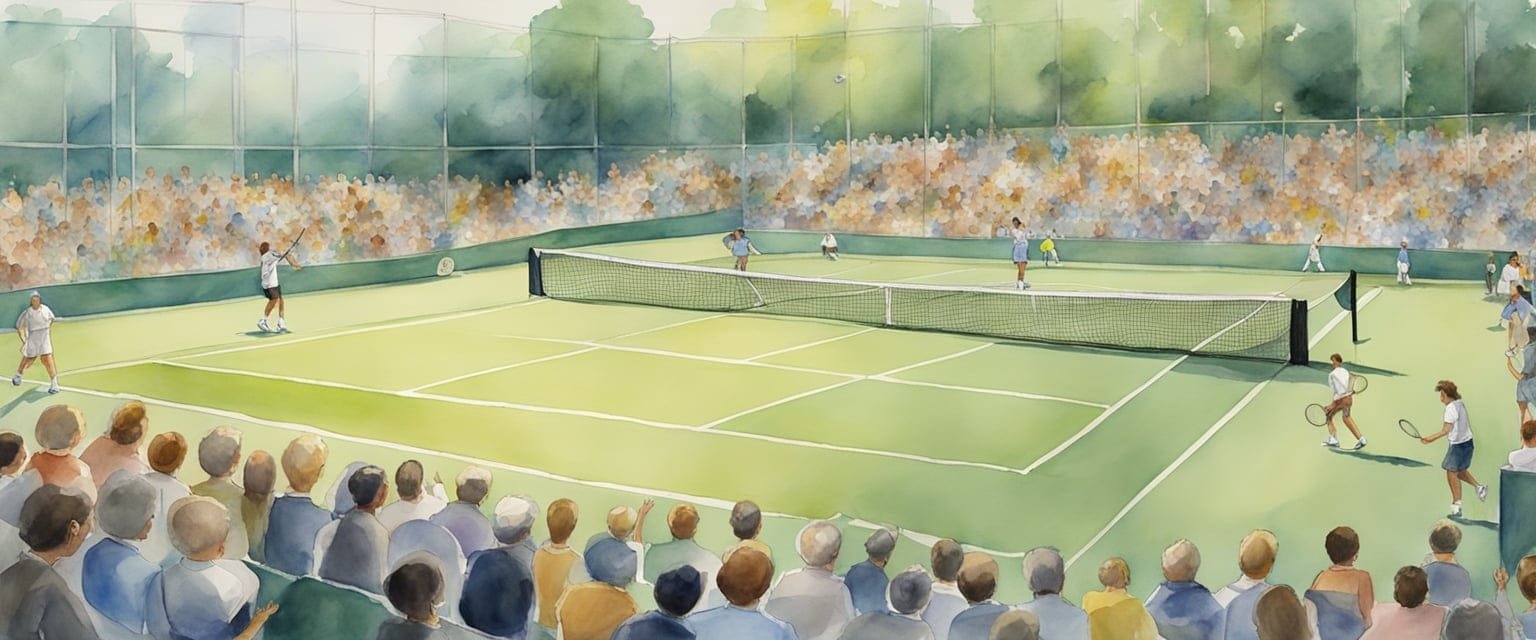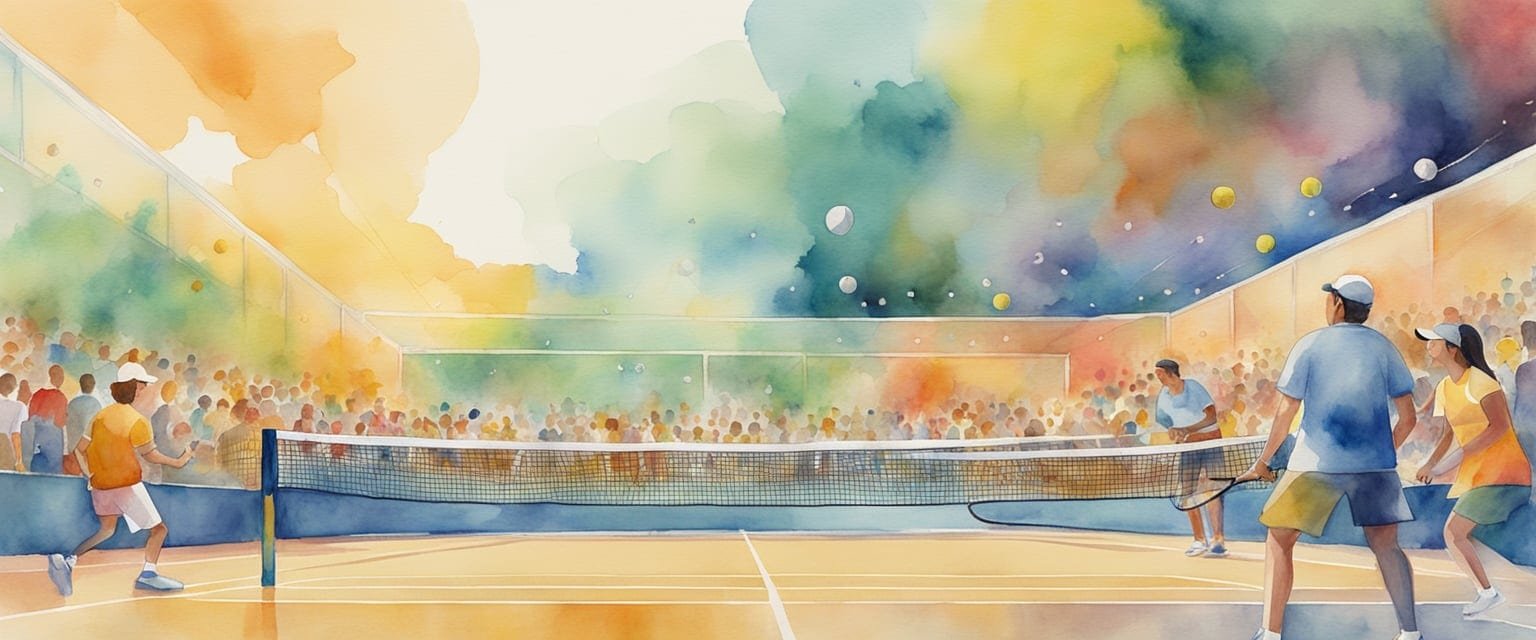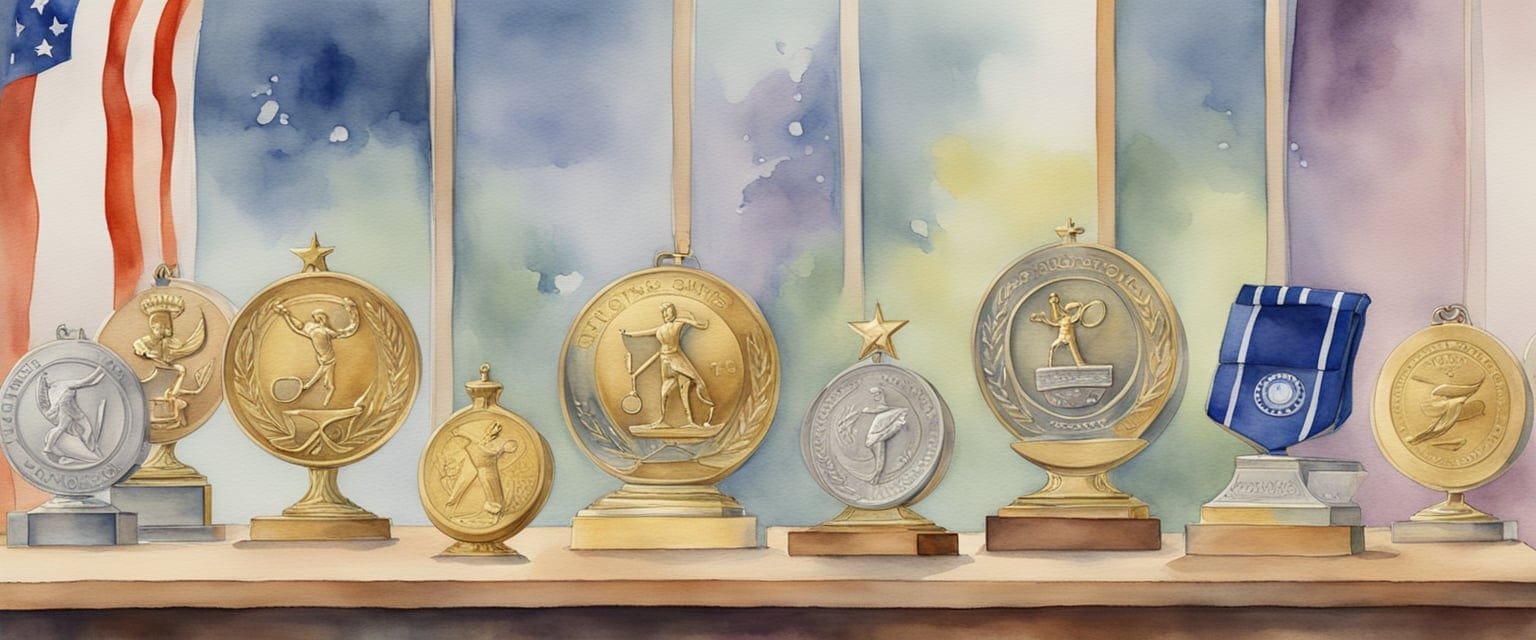Tennis has a special place in the Olympic Games, showcasing top athletes from around the world. In this ultimate guide to Olympic Tennis, I will cover everything you need to know about the events, players, and the thrilling competition ahead. With exciting matches and intense rivalries, the Olympic stage brings the sport to new heights.

As I dive into the history and structure of Olympic Tennis, I’ll share insights on event categories, qualification processes, and where the matches will take place. Whether you are a die-hard fan or a casual viewer, there’s compelling information that will enhance your experience as the games unfold.
Get ready to learn about the standout players who have made their mark and find out how to catch all the action live. The upcoming Olympics promise to deliver unforgettable moments that every tennis enthusiast should not miss.
Key Takeaways
- Olympic Tennis features various events, including singles and doubles matches.
- Major players from different countries compete for prestigious medals.
- There are exciting viewing options available for fans to enjoy the games.
History of Olympic Tennis

The history of Olympic tennis is rich and fascinating. It highlights the sport’s journey from its inception in the late 19th century to its prominence today. I want to share the key milestones that shaped Olympic tennis and the legends who made their mark.
The Genesis: 1896 Athens Olympics
The first Olympic tennis tournament took place at the 1896 Athens Olympics. This debut event featured men’s singles and doubles competitions on grass courts. It was a significant moment, marking tennis’s entry into the Olympic arena.
John Pius Boland from Great Britain won the inaugural men’s singles event. He defeated Dionysios Kasdaglis of Greece in the final. This historic victory set the stage for tennis’s evolution in the Olympics.
At the time, tennis gained popularity and the Olympic platform highlighted its appeal. The event also showcased athletes from different countries coming together. This sense of global competition and camaraderie has always been central to the Olympic spirit.
Revival and Growth: 1924-1988 Developments
Tennis was removed from the Olympics after 1924 due to disputes over regulations. This absence lasted for over six decades, and during this time, the sport evolved significantly. Many tennis legends rose to fame, but without Olympic recognition, the tennis community felt a void.
In 1988, tennis returned to the Olympic program as a full medal sport during the Seoul Olympics. This revival was a major event for players and fans alike. Athletes were finally able to compete for Olympic gold.
The return emphasized the importance of tennis in the sports world. It also made Olympic tennis a valuable achievement for athletes like Steffi Graf, who won the gold medal that year after a stunning season.
Modern Era Icons: Rafael Nadal and Novak Djokovic
In recent years, Rafael Nadal and Novak Djokovic have transformed the landscape of Olympic tennis. Both athletes are known for their incredible skills and strong competitive spirit. Nadal won the gold medal at the 2008 Beijing Olympics in singles and the bronze medal in 2016.
Djokovic, a dominant force in the sport, has also competed fiercely in the Olympics. He won the bronze medal in 2008 and aimed for gold in later Games.
These modern icons have not only elevated the sport but have also inspired younger generations. Their dedication to tennis at the Olympics highlights the sport’s enduring legacy and importance on a global stage.
Event Categories in Olympic Tennis

Olympic tennis features various exciting event categories that showcase the skills of top athletes from around the world. There are both singles and doubles formats, allowing players to compete individually or in teams.
Singles Showdown: Men’s and Women’s Singles
In the singles events, both Men’s Singles and Women’s Singles capture the spotlight. These matches are played as best-of-three sets. The players battle it out on the court to earn a chance at an Olympic medal.
The excitement builds throughout the tournament as athletes progress through the rounds. Each athlete represents their country, adding a layer of national pride to their performance. Key matches often draw large audiences, showcasing the thrilling dynamics of one-on-one competition.
Doubles Format: Men’s, Women’s, and Mixed Doubles
Doubles events in the Olympics include Men’s Doubles, Women’s Doubles, and Mixed Doubles. In men’s and women’s doubles, teams of two face off against each other in a race to win two sets.
Mixed Doubles adds a unique twist, featuring teams made up of one man and one woman. This format showcases teamwork and strategy. Players must communicate effectively to outsmart their opponents.
In all doubles matches, quick reflexes and coordinated plays are crucial for success. The camaraderie between partners creates a lively atmosphere, making these events favorites among fans.
Qualification and Rankings

In this section, I’ll explain how athletes qualify for tennis at the Olympics and the role of rankings in that process. The selection criteria are crucial for athletes hoping to compete, and understanding how the ATP and WTA rankings affect qualification is essential.
Journey to the Olympics: Qualifying Criteria
To qualify for tennis at the Olympics, athletes must meet specific criteria set by the International Tennis Federation (ITF). A primary requirement is participation in major international competitions, such as the Davis Cup for men and the Billie Jean King Cup for women.
Each country can send a limited number of players. Typically, this is a maximum of four per gender. The top 56 singles players on the ATP and WTA circuits are offered spots based on their rankings as of June 10, 2024. This date is right after the French Open, which is critical for players aiming to improve their standings.
Rankings: The ATP and WTA Influence
The rankings from the ATP (for men) and WTA (for women) are vital in shaping who gets to participate in the Olympics. Each player’s rank determines their eligibility and position during the selection process. The athletes’ performance in various tournaments throughout the year influences these rankings.
On June 10, 2024, the rankings will be finalized, playing a key role in Olympic selection. Besides singles, rankings also play a part in doubles qualification. Teams will enter based on their combined singles or doubles rankings. This system makes it important for players to maintain strong performances year-round.
Tennis Venues and Courts
The venues for Olympic tennis in Paris offer unique experiences for fans and athletes alike. The most notable site is the legendary Roland Garros, known for its clay courts, which provide a different challenge compared to hard or grass surfaces.
Parisian Clay: Roland Garros and the Olympic Advantage
Roland Garros is not just a famous Grand Slam venue; it’s also the heart of Olympic tennis in 2024. This site features 18 clay courts, creating a distinct atmosphere. Clay slows down the ball, making matches more strategic.
The main court, Philippe-Chatrier, will host the finals, showcasing top talent. It’s exciting to watch the best players adapt to this traditional surface. The Olympic advantage is that all matches will be played under the same conditions, leveling the playing field for competitors familiar with clay.
Historical Venues: Stade Roland Garros and Auteuil Gate
The Stade Roland Garros is steeped in history, built in 1928. It symbolizes French tennis and has hosted numerous legendary matches. The venue’s charm is enhanced by the surrounding gardens and classic architecture.
Nearby, the Auteuil Gate serves as the entrance, blending history with modernity. This area reflects a vibrant part of Paris. Its design complements the natural beauty of the venue. Together, these elements provide an inviting experience, making it clear why tennis fans flock here during the Olympics. The atmosphere is electric, and I can’t wait to witness the excitement.
Schedule and Match Format

When I think about Olympic tennis, the schedule and match format are key parts of the experience. Knowing when matches take place and how the tournament unfolds helps us enjoy the games to the fullest.
Olympic Tennis Schedule: Daily Play and Key Matches
The tennis event during the Olympics runs from July 26 to August 11, 2024. Each day features several matches, and it’s important to keep track of when your favorite players are on the court.
For example, men’s and women’s singles matches will occur throughout the first week. Key matches, like the quarterfinals, are happening in the second week, setting the stage for the semifinals and finals.
Here’s a simple breakdown of the schedule:
- July 26-August 4: Initial rounds for singles and doubles.
- August 5-7: Quarterfinals for both events.
- August 8: Semifinals.
- August 10: Bronze medal matches.
- August 11: Gold medal matches.
Fans should note specific times for each match as they can vary daily.
Match Dynamics: Understanding Single-Elimination Tournaments
Olympic tennis uses a single-elimination format. This means that players are out of the tournament if they lose a match. Each match counts, making every point crucial.
The structure usually starts with a large draw that narrows to the top players. After the opening rounds, the quarterfinals feature the final eight players. Winners move to the semifinals, where they compete for a chance at gold and silver medals.
The losers of the semifinals play for the bronze medal. This setup adds excitement and tension as every player aims for victory to advance.
Keeping this format in mind helps me appreciate the strategy and skill involved in each match.
Awards and Medals

Olympic tennis is not just about winning matches; it’s also about the awards and recognition that come with great performance. The medals awarded at the Olympics symbolize the hard work and dedication of each athlete. Let’s dive into what these achievements mean.
Striving for Gold: The Prestige of Olympic Medals
Winning a gold medal at the Olympics is one of the highest honors in sports. For tennis players, this award represents years of training and effort.
The gold medalists get to stand on the podium, draped in their national flag, while their anthem plays. This moment is cherished forever and is often seen as the pinnacle of an athlete’s career. Notable players like Venus Williams have won multiple gold medals, highlighting the significance of this achievement in the sport.
Winning gold also elevates an athlete’s profile, leading to more endorsements and fan support. It’s a chance to inspire others through their success and sportsmanship.
Beyond Victory: Silver and Bronze Achievements
Not every athlete can claim the gold, but silver and bronze medals are equally significant. These medals showcase the skill and competitive spirit of the players who reach the podium.
Silver medalists have fought hard and often come close to victory, showing great talent and resilience. Bronze medalists also demonstrate exceptional skill.
Both awards grant recognition and honor. Athletes like Kathleen McKane Godfree have made their mark with a collection of medals, emphasizing that every podium finish tells a story of dedication and hard work.
These achievements are celebrated in every corner of the globe and inspire young athletes to strive for their own success in the future.
Prominent Olympic Tennis Players
In the world of Olympic tennis, some players consistently stand out. Both established icons and emerging talents shape the competition. I’ll highlight a few key players who inspire us and set trends in the game.
Icons of the Court: Profiles of Top Competitors
Some players have made their mark as Olympic legends. Alexander Zverev returns as a defending champion, having won gold in Tokyo. His powerful game makes him a formidable opponent in men’s singles.
Iga Swiatek is another player to watch. The Polish star is known for her incredible agility and strategic play, which can shine in women’s singles. Andy Murray continues to impress, bringing experience and grittiness. He’s a two-time Olympic gold medalist who excels in both singles and doubles.
Belinda Bencic also deserves a mention. She won gold in women’s singles in Tokyo and is back to defend her title. These players bring excitement and excellence to the Games.
Rising Stars: The New Generation
The new generation of players is equally thrilling. Carlos Alcaraz is a standout. His youthful energy and skill make him a top contender in men’s singles. Coco Gauff, known for her vibrant personality and powerful serves, is quickly making a name for herself in women’s singles and doubles.
Daniil Medvedev brings a unique playing style that challenges opponents. Jessica Pegula and Caroline Garcia are also rising through the ranks, showing potential for great achievements. Keep an eye on Emma Navarro and Arthur Fils; they bring fresh talent to the court.
I’m excited to see how these players perform in the upcoming Olympic Games!
Viewing the Games

Watching Olympic tennis is an exciting experience, and I want to make sure you know how to catch every moment. With various broadcasting options and streaming services available, it’s easy to enjoy the games from wherever you are.
Broadcasts and Coverage: NBC, Eurosport, and More
NBC holds the broadcasting rights for the Olympic Games in the United States. I can catch live coverage on their main channels as well as on CNBC and USA Network. The Opening Ceremony will air on July 26, providing a perfect kickoff to the tennis events.
In Europe, Eurosport will be my go-to for comprehensive coverage. They offer extensive reporting on all Olympic sports, including tennis. Local networks may also provide coverage, so I can check listings to ensure I don’t miss any matches.
On-Demand and Online: Streaming Options
For those who prefer watching on the go, there are several streaming options available. I can access live tennis matches via Peacock, NBC’s streaming service. This is especially useful for watching on mobile devices or computers.
If I want to catch up on missed matches, replays are often available shortly after the games end. Many platforms will provide highlights as well. This way, I can enjoy the action at my convenience and never miss a big moment in Olympic tennis.
Planning Your Experience

When attending the Paris 2024 Olympic Games, careful planning can enhance my experience. From travel tips to securing tickets for tennis matches, each detail can make my visit enjoyable and memorable.
Traveling to Paris: Tips for the Olympic Attendee
Traveling to Paris for the Olympics is exciting. First, I should book my flights early to get the best deals. Look for flights that arrive a few days before the events to adjust to the time difference and explore the city.
Once I’m in Paris, I can use public transport like the metro to navigate easily. I should consider getting a Paris Visite pass for unlimited travel on public transport. It will save me time and money.
I can also find diverse accommodations, from hotels to short-term rentals. Staying near the tennis venue can be convenient. I should check local restaurants and markets for delicious French cuisine.
Securing Tickets: How to Watch the Matches Live
Getting tickets for the tennis events at the Paris 2024 Olympics is critical. I can buy tickets through official channels like Olympics.com. It is essential to act fast, as popular matches will sell out quickly.
Additionally, I should check the schedule carefully. Matches for men’s and women’s singles will begin on July 27, and finals will take place on August 3 and 4.
If I can’t secure tickets, I shouldn’t worry. France Télévisions will broadcast many events on channels like France 2, France 3, and France 5. This way, I can still enjoy the excitement of the games from my hotel room or a local café.
Frequently Asked Questions
In this section, I’ll answer some common questions about Olympic tennis. From recent winners to how fans can watch the matches, I’ll cover various important topics.
Who are the most recent winners of Olympic tennis for both men and women?
At the Tokyo 2020 Olympics, the men’s singles gold medal was won by Alexander Zverev from Germany. In women’s singles, the gold medalist was Belinda Bencic from Switzerland. These players set a high standard for the upcoming 2024 Games.
What does it take for tennis players to qualify for the 2024 Olympics?
To qualify for the 2024 Olympics, players must earn ranking points in international tournaments. The top players from the ATP and WTA rankings will secure spots. There are also qualification events where other players can compete for a chance to participate.
How can fans watch the tennis matches at the 2024 Olympic Games?
Fans can watch the tennis matches at the 2024 Olympics through various broadcasting channels. Many countries will offer live coverage on television, and streaming options will also be available online. It’s best to check local listings for the exact details.
Which tennis athletes will represent Team USA in the 2024 Olympics?
The official Team USA roster for tennis won’t be announced until closer to the Games. However, top American players like Serena Williams and Frances Tiafoe have a good chance of representing the country. Their performances in the upcoming tournaments will determine their selection.
What are the notable changes in the tennis event for the 2024 Olympics?
One notable change for the 2024 Olympics is the competition schedule, which might be adjusted to accommodate more matches. Additionally, the format will remain consistent with previous years, closely resembling major tournaments like Grand Slam events.
Who are some of the potential medal contenders in Olympic tennis in 2024?
Potential medal contenders include top-ranked players like Novak Djokovic and Iga Swiatek. Their recent performances in tournaments show they have the skills to compete for medals. Young emerging talents may also surprise everyone and challenge the current champions.

